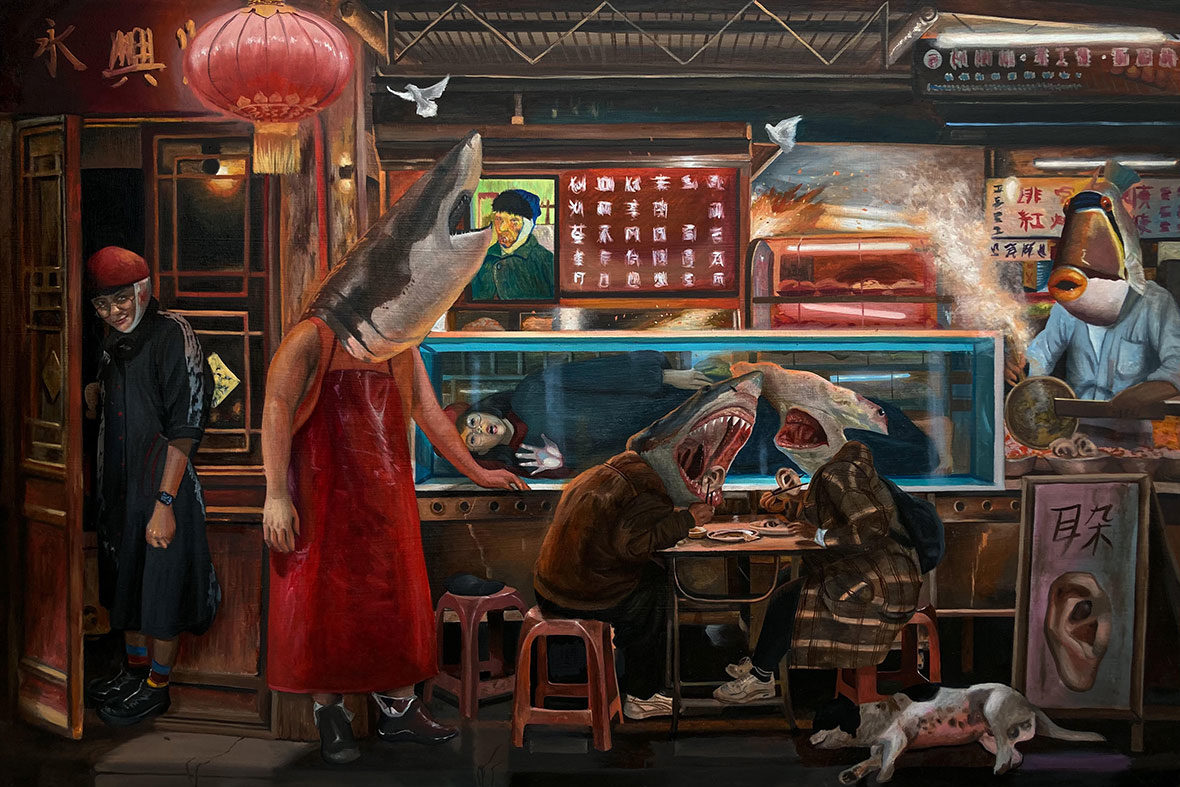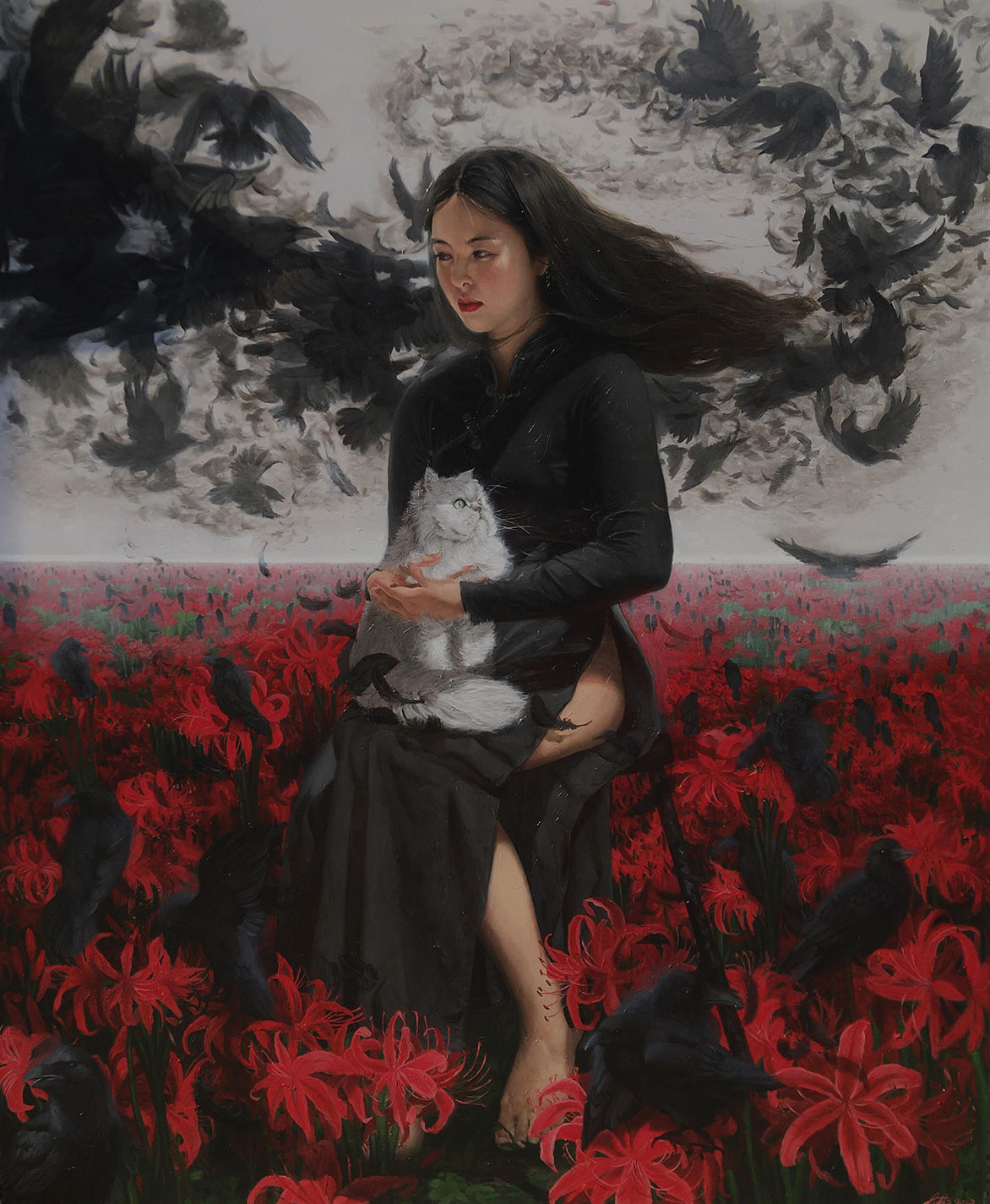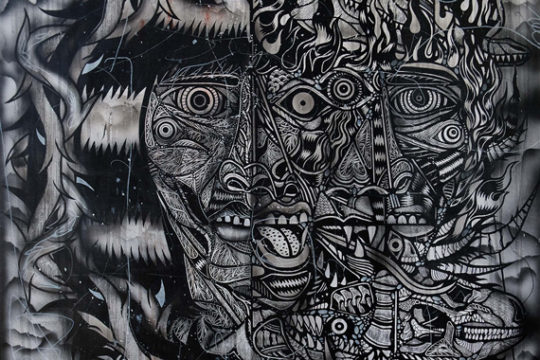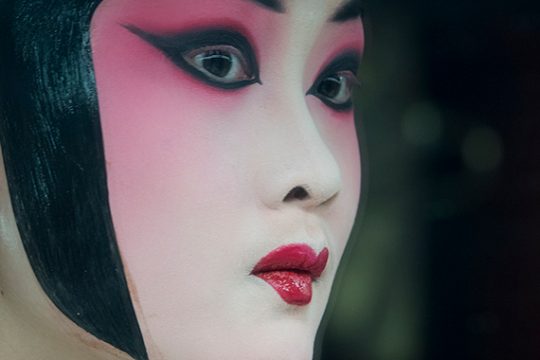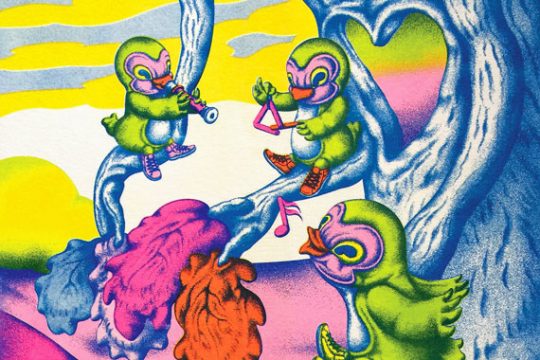
In Bangkok’s Chinatown, shark fin restaurants are prolific, competing on both sides of the road, proudly displaying the awards they’ve accumulated. It’s an extremely popular dish, but it’s also a brutal one where the sharks’ fins are chopped off while they’re still alive before they’re dumped back into the ocean to drown. And it happens on a massive scale. What if this were flipped and it was humans having their appendages callously lopped off as a nutritionless delicacy?
That’s how Thai painter Puntita Meeboonsabai imagines things. Under the romantic glow of a rice lamp, a hipster shark couple messily snacks on a dish of human ears while a human girl suffocates in a fish tank display. Ears are advertised on a sign board and a menu, with a picture of Van Gogh hanging on the restaurant wall for good measure.
曼谷的唐人街拥有不少鱼翅餐厅,这些餐馆在马路两边争相揽客,扬扬得意地把鱼翅展示在路人面前。鱼翅在当地是深受喜爱的美食之一,而生意背后的真相也是极其残忍的。鱼翅往往是从鲨鱼身上活活割下,而被割掉鱼翅的鲨鱼会被扔回海里,等待它们的只有死亡。现如今,鱼翅生意已经形成一种大规模商业化活动。但如果我们换位思考,倘若我们的四肢被无情割掉,用来烹饪毫无营养的美味,会引发怎样的思考?
这是泰国画家 Puntita Meeboonsabai 的大胆构想。在她的作品中,你会看到鲨面人身的顾客正大快朵颐地享用一盘人类耳朵做成的菜肴,鱼缸里不再是鱼,而被换成绝望的人类自己。餐馆的招牌和菜单上全是有关耳朵美食的广告,餐厅墙上还挂着梵高遮盖耳朵的自画像作为品质保证。
Although the shark fin painting is one of Meeboonsabai’s more straightforwardly vocal pieces, it’s also typical of her style, which oscillates between war epics between wildlife and subdued portraits brimming with meaning. Her oil paintings are fun and playful but delivered with nuanced meaning just waiting to be discovered by mindful viewers.
In one painting, a girl rides a zebra as it leaps through the air, surrounded by fire and explosions. Animals of all types fill the war scene with several battles playing out at once. It has the lighthearted feel of an animated teen blockbuster movie, and this is intentional. Meeboonsabai is actively trying to be inviting, all in the hopes of reaching viewers with a heavy message: Humans are no better than animals when we engage in war for profit, and we’re likely to bring down the rest of the world with us.
这幅以鱼翅为主题的画作是 Puntita 早期开门见山的作品之一,其蕴藏美学特点一直贯穿至今,乃至野生动物之间史诗般的战斗场景,或是别有深意的人像作品。在她俏皮风趣的油画作品之下,皆藏着微妙深意,等待细心的观众去发现。
一幅作品中,女孩骑着斑马翱翔于天际,四周是战场的烈火与硝烟。整个场景中充斥各式各样的动物,卷入数场战斗。Puntita 希望通过天马行空的想象力鼓励人们思考去一个严肃的讯息:当人类为了利益发动战争时,与野兽无异,最终世界将毁于一旦。


In another piece, a fighter plane shoots down a 727 over an ocean with volatile waves. Animal refugees floating on debris are everywhere you look. To put it all into perspective, depictions of space and galaxies are visible in the background, totally ignored as we destroy ourselves and our only home. “Although many of my paintings depict scenes that could never happen in the real world, I’m trying to discuss very real, globally important topics,” Meeboonsabai says.
Meeboonsabai’s use of animals changes depending on the painting. Museums are a common theme in her work, and they’re frequently overwhelmed by hordes of beasts. But in these cases, she’s criticizing institutional conformity. Upper classes who’ve decided what’s proper and pull up the ladders after them, keeping the raucous throngs at bay. “If a great number of animals visited a museum, they certainly wouldn’t follow the rules,” she smiles. “But of course, this could never happen… unless somebody let it happen.”
另一幅作品中,波音 727 客机受到猛烈袭击,最终坠入海洋掀起阵阵涛浪。在劫逃难的动物们漂浮在海面的飞机残骸上,而背景中璀璨的银河星系依旧清晰。当人类自相残杀,摧毁各自唯一的家园时,已经将太空和银河抛之脑后,然而,我们也仅仅是这个世界的一粒沙罢了。“虽然我的许多作品画的都是现实世界中不可能发生的场景,但我想藉此探讨一些在全球各地真实发生的重要话题,”Puntita 说。
博物馆是她作品中常见元素之一,往往塞满了成群结队的动物。Puntita 运用该元素来批判人类的固化制度。上层阶级主宰一切,不断拉起身后的梯子,阻止平民攀升。她笑着说:“当大量动物涌进博物馆时,它们肯定不会遵守那些既定的规章制度。”


Not all of Meeboonsabai’s work is meant for mass consumption, however. A lot of her output is dark and quiet, particularly her portraits. Many of her characters are sheathed in a red hood in reference to people’s need to hide their true selves from judgment. “Although we may criticize her from afar, her ability to hide offers freedom.” Often, the girl in the hood is a self-portrait. Over a series of four paintings, she painted herself prone on the floor in the fetal position. “This was during a difficult period when I was having trouble handling anything. It’s a reminder for myself of those days of confusion and exhaustion.”
然而,并非 Puntita 的所有作品都具有恢弘、或是外向的场面,她还有很多风格较为暗黑和安静的作品,尤其是她的肖像画作品。她笔下的角色很多时候都配有红色斗篷,以此寓意人们为逃避评判,隐藏真实的自己。很多时候,斗篷下的女孩就是她自己。在一组由四幅作品组成的系列画作中,她更以婴儿蹒跚于地面来映射自己的心境,她说:“那是我所经历的人生低谷时期,这幅作品是为了让我记得那些困惑和疲倦的日子。”
Death is another common topic that Meeboonsabai approaches through portraits. In one diptych, she has a character holding a skull in each painting, one in her lap, the other in front of her face. Here she’s saying we’re in charge of our own fates and can choose when our time should arrive.
The death of beauty is another challenge, one Meeboonsabai discusses with a black, red, and white pair of paintings connected by persimmon flowers. The flower resembles death or a final farewell, but in full bloom, she sees a pinnacle of beauty. “Like the woman in the picture, this is the most beautiful time for flowers. But life goes on and that period can never return.” To create a sense of that time passing, one painting is bright, full of white doves, flowers, and a dress, the future hinted at with a black panther circling below. The next is full of black ravens and she’s donned a black dress. There’s no turning back anymore.
“死亡”是 Puntita 在人像作品中探讨的另一个重要话题。在上面这幅双联画作品中,主人翁在每幅画中各拿一个头骨,分别放在大腿和面颊上。她解释道:“我们掌握着自己的命运,可以自行选择自己的离开世界的时间。”
创作中,Puntita 同样对“美的消逝”主题进行讨论,她用白、黑、红三色与柿子花联系在一起。柿子花象征死亡或最后告别,与此同时,它的盛开也外化地表现着美的极致。“就像画中的女人一样,鲜花绽放的一刻是最美丽的,但生活仍然在继续,这个巅峰时期一去不复返。”为了营造一种时间流逝的感觉,她用颜色的对比来进行隐喻,例如用鲜花、白鸽和裙子的鲜艳来比喻现在,用迷失彷徨的黑豹来暗示未来。这仿佛也说明着一个道理 —— 星在转,海在动,我们仍旧是我们,只不过都是这世界的过客罢了。
Like our stories? Follow us on Facebook and Instagram.
Instagram: @puntitabow
Contributor: Mike Steyels
Chinese Translation: Olivia Li

